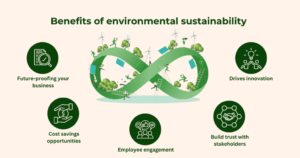Environment Sustainability

Key Aspects of Environmental Sustainability :
-
Resource Conservation:
This involves using natural resources (like water, minerals, forests, and energy) wisely and efficiently, minimizing waste, and promoting recycling and reuse Environment Sustainability. The goal is to avoid depleting these finite resources and to allow renewable resources to regenerate.
-
Pollution Prevention: Reducing and eliminating pollution of air, water, and soil is critical. This includes managing waste effectively, reducing greenhouse gas emissions, and preventing the release of toxic chemicals.
-
Biodiversity Protection:
Maintaining the variety of life on Earth, from genes to ecosystems, is fundamental. Biodiversity provides essential ecosystem services like pollination, water purification, and climate regulation. Loss of biodiversity weakens these systems.
-
Ecosystem Health:
Ensuring that natural systems like forests, oceans, wetlands, and grasslands remain healthy and resilient. These ecosystems provide vital services that support all life on Earth.
-
Climate Action:
Addressing climate change by reducing greenhouse gas emissions (e.g., from burning fossil fuels, deforestation) and adapting to its impacts. This is arguably the most pressing environmental sustainability challenge of our time.
-
Sustainable Consumption and Production:
Shifting away from a linear “take-make-dispose” economy to a more circular one where products are designed for durability, reuse, and recycling, minimizing resource input and waste output.

Why is it so important?
Our planet’s resources are finite, and our current consumption patterns are placing immense pressure on natural systems Environment Sustainability. Climate change, biodiversity loss, and pollution are not just environmental problems; they are economic, social, and health crises. Achieving environmental sustainability is essential for:
- Human Well-being: Access to clean air, water, food, and a stable climate are fundamental human rights.
- Economic Stability: A healthy environment underpins industries like agriculture, fishing, and tourism Environment Sustainability . Environmental degradation can lead to significant economic losses.
- Social Equity: Environmental burdens often disproportionately affect marginalized communities Environment Sustainability. Sustainability aims for a just and equitable distribution of environmental benefits and burdens.
- Future Generations: We have a moral obligation to leave a habitable planet for those who come after us. Environment Sustainability
Images of Environmental Sustainability:
While I cannot directly display images, I can describe what you would typically see in images representing environmental sustainability. Imagine visuals that evoke:
- Renewable Energy: Wind turbines against a scenic landscape, solar panels on rooftops, hydroelectric dams.
- Healthy Ecosystems: Lush green forests, pristine oceans with vibrant marine life, thriving wetlands, clean rivers.Environment Sustainability
- Sustainable Practices: People engaged in recycling, composting, urban gardening, sustainable agriculture (e.g., organic farms, permaculture).https://www.nature.org/en-us/
- Eco-friendly Innovations: Electric vehicles, green buildings with living roofs, bicycles as a mode of transport.
- Global Unity: Images of the Earth from space, hands holding a small plant or a globe, diverse groups of people working together for environmental protection.
In this informative video, we explore the concept of sustainable developmen
You can find many such images by searching on stock photo websites like iStock, Shutterstock, or Getty Images for terms like “environmental sustainability,” “renewable energy,” “eco-friendly,” “conservation,” or “sustainable development.”Environment Sustainability
External Links to Organizations Promoting Environmental Sustainability:
Here are some reputable organizations that are leading the way in environmental sustainability efforts, offering valuable information, research, and initiatives:
- United Nations Environment Programme (UNEP): UNEP is the leading global environmental authority that sets the global environmental agenda, promotes the coherent implementation of the environmental dimension of sustainable development within the United Nations system, and serves as an authoritative advocate for the global environment.

- World Wildlife Fund (WWF): WWF is a global conservation organization that works to conserve nature and reduce the most pressing threats to the diversity of life on Earth.https://discovershpere.in/
- Environmental Defense Fund (EDF): EDF is a leading international non-profit organization that links science, economics, law, and innovative private-sector partnerships to create environmental solutions.
- World Resources Institute (WRI): WRI is a global research organization that spans more than 60 countries, with offices in Brazil, China, Europe, India, Indonesia, Mexico, and the United States. Their more than 1,000 experts and staff work closely with leaders to turn big ideas into action at the nexus of environment, economic opportunity and human well-being.

- International Institute for Sustainable Development (IISD): IISD is an independent think tank that champions sustainable development through research, analysis, and communication.
- Ceres: Ceres is a non-profit organization working with the most influential capital market leaders to solve the world’s greatest sustainability challenges.
- The Nature Conservancy: The Nature Conservancy is a global environmental nonprofit working to create a world where the diversity of life thrives, and people act to conserve nature for its own sake and for its ability to fulfill our needs and enrich our lives.
No Responses